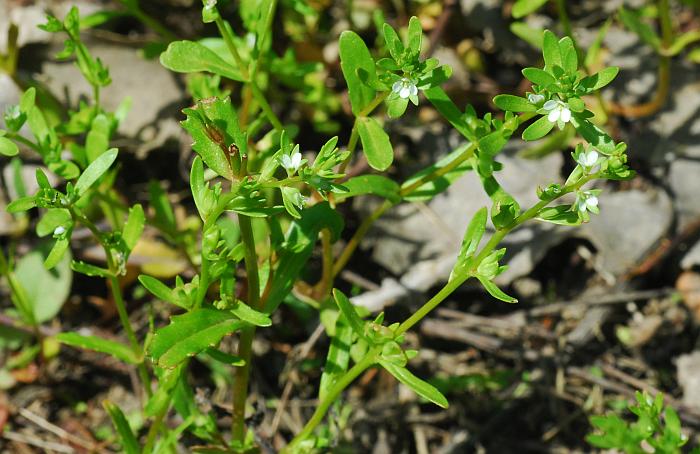Veronica peregrina L.
Neckweed

Native
CC = 0
CW = 0
MOC = 74
© SRTurner
Veronica peregrina L.Neckweed | |
 |
Native CC = 0 CW = 0 MOC = 74 |
© SRTurner |
|
Family - Plantaginaceae Habit - Annual forb with fibrous roots or a slender taproot, lacking rhizomes. Stems - Weakly ascending to erect, to 30 cm, sometimes from a spreading base, usually not rooting at the lower nodes, sometimes multiple from base, glabrous to moderately pubescent with short, glandular hairs.
Leaves - Opposite, decussate, mostly sessile. Lowermost leaves sometimes short-petiolate. Blades 0.5-2.2 cm long, 1-4 times as long as wide, mostly relatively thick, narrowly oblong to oblong-oblanceolate, those of the petiolate leaves often lanceolate to ovate, mostly rounded or broadly and bluntly pointed at the tip, angled or short-tapered to rounded, or occasionally nearly truncate at the base, not clasping the stems, the margins unlobed, flat, entire or shallowly and irregularly scalloped or bluntly toothed, the surfaces glabrous or sparsely to moderately pubescent with short, glandular hairs.
Inflorescence - Terminal, elongate, open, spikelike racemes, appearing as flowers solitary in the leaf axils (because the bracts are unreduced and the inflorescence frequently extends nearly to the stem base), with 6-20 flowers, the axis visible between the flowers, the bracts 4-10 mm long, similar to the adjacent foliage leaves, narrowly oblong to narrowly oblanceolate, the uppermost bracts sometimes linear. Flower stalks absent or to 1 mm long at flowering, shorter than the calyces, when present more or less ascending at flowering and fruiting.
Flowers - Calyces 3-6 mm long, the lobes subequal, deeply 4-lobed, the lobes narrowly elliptic to lanceolate, glabrous or glandular-hairy. Corollas 2.0-2.5 mm wide, 2.5-3.0 mm long, white, lacking darker veins, 4-lobed, the throat white or sometimes light greenish-tinged, the tube appearing relatively broad, wider than long, the lobes curved outward. Style 0.1-0.4 mm long at fruiting. Stamens 2, included to slightly exserted. Ovary obcordate, compressed, glabrous to glandular-pubescent, green.
Fruits - Obcordate capsules 3-4 mm long, about as long as wide, heart-shaped in profile, flattened, the notch broad and moderately deep (0.2-0.5 mm), the surfaces and/or margins glabrous or glandular-hairy, dehiscing along the sutures into 2 valves. Seeds numerous, 0.5-1.0 mm long, strongly flattened on both sides, but with a slender longitudinal ridge on one side, the surfaces appearing smooth or slightly pebbled, light brown to yellowish brown.
Flowering - April - August. Habitat - Bottomland forests, pond margins, riverbanks, bases of bluffs, marshes, fens, fields, lawns, pastures, ditches, railroads, roadsides, and open, moist, disturbed areas. Origin - Native to the U.S. Lookalikes - V. serpyllifolia. Other info. - This little plant is commonly overlooked, as the flowers are quite small and not brightly colored. It is common across Missouri and the entire continental U.S., likely to be found anywhere with open patches of moist ground. The small, four-lobed flowers and heart-shaped fruits are sufficient to identify the plant as belonging to the Veronica genus. In Missouri there are only two common species of Veronica with white flowers, one being V. peregrina. The other, V. serpyllifolia, has inflorescences which are more clearly defined due to bracts which are abruptly smaller than the foliage leaves. That plant is also perennial and rhizomatous. Photographs taken in Brown Summit, NC., 4-4-03; also at Klondike County Park, St. Charles County, MO, 4-29-2015, and near Labadie, Franklin County, MO, 5-2-2020 (SRTurner). |